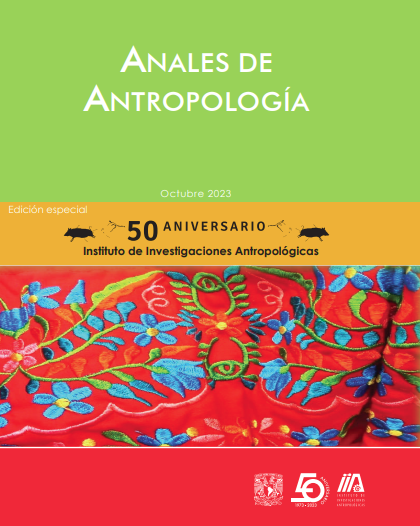The Light of Ecotourism: the Social Production of Fireflies and the Traps of Neoliberal Faith
Main Article Content
Abstract
Downloads
Article Details
References
Antonioni, Alberto y Alessio Cardillo (2017). “Coevolution of Synchronization and Cooperation in Costly Networked Interactions.” Physical Review Letters, 118(23): 1-5.
Bennet, Jane (2010). Vibrant Matter. A Political Ecology of things. Londres: Duke University Press, 200 pp.
Boletín UNAM-DGCS-229 (2014). Descubre universitario nuevo género de luciérnagas.
Disponible en http://www.dgcs.unam.mx/boletin/bdboletin/2014_229.html [Consultado el 30 de julio de 2018].
Braidoti, Rosi (2015). Lo posthumano. Vol. 302622. Editorial Gedisa.
Branham, Marc (2005) How and why do fireflies light up? En Scientific American. Disponible en: https://www.scientificamerican.com/article/how-and-why-do-fireflies/?redirect=1 [consultado el 19 de mayo de 2019]
Braun, Bruce (2008). “Environmental Issues: Inventive Life”. Progress in Human Geography, 32(5): 667-79.
Brockington D., R. Duffy y J. Igoe (2008) Nature Unbound: Conservation, Capitalism, and the Future of Protected Areas. Earthscan, Londres.
Castree, Noel (2003). “Environmental Issues: Relational Ontologies and Hybrid Politics”. Progress in Human Geography, 27(2): 203-211.
Chacón, C. Judith (2021). “Descubren nueva especie de luciérnaga en Edomex, llevará nombre matlatzinca”. Así sucede, confianza en la noticia, Noticias de Toluca y el Estado de México. 4 de julio de 2021 [en línea] Disponible en: https://asisucede.com.mx/descubren-nueva-especie-de-luciernaga-en-edomex-llevara-nombre-matlatzinca/ (Consulta el 17 de mayo de 2022.)
Coole, D. y Frost, S. (2010). Introducing the new materialisms en Bennett, J., Cheah, P., Orlie, M. A., & Grosz, E., New materialisms: Ontology, agency, and politics, Duke University Press: 1-43.
Durand, Leticia, y Juanita Sundberg (2019). “Sobre la ecología política posthumanista”. Sociedad y Ambiente, núm. 20: 7–27.
Ferreira, V. S., O. Keller y M. A. Ivie (2022). Descriptions of New Species of Chespirito Ferreira, Keller & Branham (Coleoptera: Lampyridae: Chespiritonae) and the First Record for the Subfamily in the United States. Zootaxa 5124 (2): 230-237.
González, D.C. (2021). “Butterflies, organized crime, and ‘sad trees’: A critique of the Monarch Butterfly Biosphere Reserve Program in a context of rural violence”. World Development 142: 105420.
Haraway, D. J. (1991). A Cyborg Manifesto: An ironic dream of a common language for women in the integrated circuit. In The Transgender Studies Reader Remix (pp. 429-443). Routledge.
Igoe, J., (2010) The spectacle of nature in the global economy of appearances: Anthropological engagements with the spectacular mediations of transnational conservation. Critique of Anthropology 30(4): 375-397.
Igoe, J. y D. Brockington (2007) Neoliberal Conservation: A Brief Introduction. Conservation and Society 5(4): 432-449.
Kirksey, S. E., & Helmreich, S. (2010). The emergence of multispecies ethnography. Cultural anthropology, 25(4): 545-576.
La Jornada Estado de México (2022)."Fomentan el cuidado de luciérnagas tras descubrimiento de dos especies” CULTURA Jueves 7 de julio de 2022: 6. Disponible en: https://static.lajornadaestadodemexico.com/wpcontent/uploads/2022/07/EdomexImpresion-07072022-1.pdf [consultado el 9 de diciembre de 2022].
Lewis, S.; A. Thancharoen, Ch. Hay Wong, T. López-Palafox, P. Velasco Santos, Ch. Wu, L. Faust, R. De Cock, A. C.S. Owens, R. H. Lemelin, H. Gurung, W. F.A. Jusoh, D. Trujillo, V. Yiu, P. Jaramillo López, S. Jaikla, J. M. Reed (2021). Firefly tourism: Advancing a global phenomenon toward a brighter future. Conservation, Science and Practice e391: 1-18.
DOI: https://doi.org/10.1111/csp2.391
Maquitico, Y.; Vergara, A.; Villanueva, I.; Camacho, J.; Cordero; C. (2022). Photuris lugubris
Female Fireflies Hunt Males of the Synchronous Firefly Photinus palaciosi (Coleoptera: Lampyridae). Insects, 13: 915. Disponible en : https://doi.org/10.3390/insects13100915 [consultado el 20 de enero de 2023].
Nutini, H. G. y J. M. Roberts (1993). Bloodsucking witchcraft: an epistemological study of anthropomorphic supernaturalism in rural Tlaxcala, Arizona, EE.UU.: The University of Arizona Press.
Ogden, L. A., Hall, B., & Tanita, K. (2013). Animals, plants, people, and things: A review of multispecies ethnography. Environment and society, 4(1): 5-24.
Perdomo, J. C. (2019). Agencias, mundos y ontologías como escenarios de problematización de la antropología contemporánea. Maguaré, 33(2): 25-68.
Sundberg, J. (2011). Diabolic Caminos in the desert and cat fights on the Rio: a posthumanist political ecology of boundary enforcement in the United States–Mexico borderlands. Annals of the Association of American Geographers, 101(2): 318-336.
Tsing, A. (2013). “More-than-human sociality: a call for critical description”. In Anthropology and nature. Routledge: 37-52.
Zaragoza-Caballero, S., S. López-Pérez, M. González-Ramírez, Geovanni M. Rodríguez-Mirón, et al., (2023) Luciérnagas (Coleoptera: Lampyridae) del norte-occidente de México, con la descripción de 48 especies nuevas. Revista Mexicana de Biodiversidad 94 (e945028): 1-81.
Zaragoza-Caballero, S., S. López-Pérez, V. Vega-Badillo, et al.
(2020). Luciérnagas Del Centro de México (Coleoptera: Lampyridae): Descripción de 37 Especies Nuevas. Revista Mexicana de Biodiversidad 91(e913104): 1–70.
Zaragoza-Caballero, S. (2012). Macrolampis palaciosi (Coleoptera: Lampyridae: Photinini, Tlaxcala, México. Dugesiana, 19, 117–121.

This work is licensed under a Creative Commons Attribution-NonCommercial-NoDerivatives 3.0 Unported License.
Esta revista usa una licencia CC del tipo CC BY-NC-ND 3.0. Se maneja bajo el esquema de acceso abierto, con una licencia Creative Commons Attribution-NonCommercial-NoDerivs 3.0 Unported.
